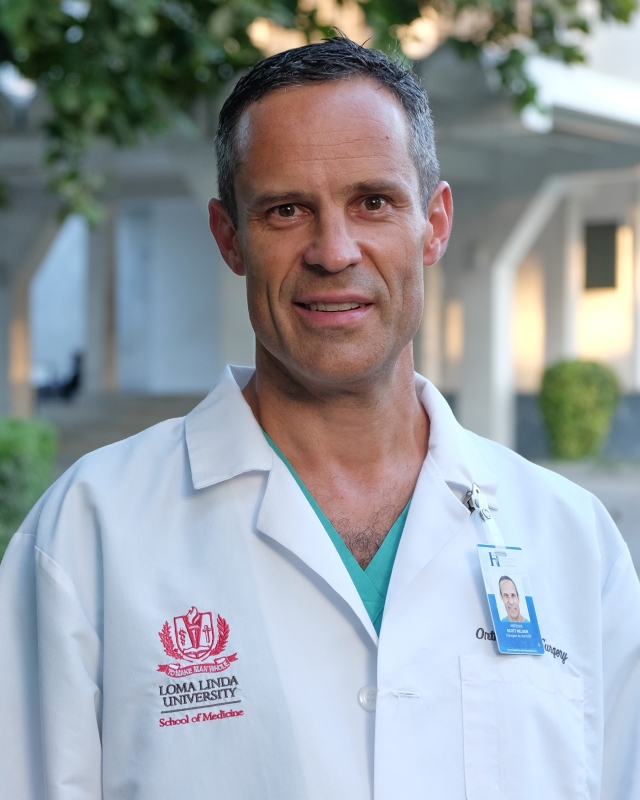
Scott Nelson, MD,
Personal Investment
After serving in the Dominican Republic for five years, my wife Marni and I were considering our next move, asking for God’s guidance. We had some options and returning to Southern California was not our first choice. A book about my maternal grandfather, a surgeon in Africa, Bwana Munanga (aka medicine man in Kiluba) from Pacific Press, influenced us to move overseas. And now another book, For God and C.M.E., about my great, paternal great-grandfather Percy Magan was reminding us about the mission of Loma Linda and influencing our move back to the United States.
Disaster strikes
In 2010 we had decided to return to Loma Linda from the Dominican Republic. Just before this transition, an earthquake struck Port au Prince, Haiti’s capital. I had been to Haiti many times, but had no idea how bad the situation was. Less than 48 hours later, I walked into one of the deadliest disasters in world history. There were more orthopedic emergencies than anyone could imagine.
Haiti Adventist Hospital (HAH), in Port Au Prince, the closest major hospital to the epicenter of the quake, was still standing, but was run down and in a state of disrepair. This is a well-built hospital that was founded in 1981 and at one time had a great reputation. But as outside support dwindled, the hospital was left to fend for itself. With dependence only on local resources, poor people had been turned away for years, conditions were deplorable, and the hospital had been barely functioning. Unfortunately, this state of deterioration is a reality in many Adventist mission hospitals.
But with tragedy comes opportunity. This disaster brought unprecedented resources to Haiti and to HAH. It was time to restore the hospital mission which is “to continue the healing ministry of Jesus Christ by providing quality care to all classes of people.” Institutions, donors, and volunteers responded to this disaster by helping HAH give emergency treatment to the overwhelming number of victims. A longstanding need for orthopedic surgery in Haiti was suddenly magnified. And HAH was able to step up in an unprecedented way. Since that time the growth and reputation of the orthopedic program and the entire hospital has continued to grow.
Long term commitments
One lesson learned is that short term service is no substitute for the long term commitments that many missionaries made in the past. The value of building relationships, learning a language and integrating into a culture cannot be replaced by doing surgery for a week and donating some materials. Fortunately, during the years following the earthquake there were several who did make long term commitments to HAH, and with support from Loma Linda University the process of restoration continued to move forward.
Over the next several years while working at LLU, I made multiple short term trips to HAH every year to support the orthopedic surgery program. I was quite content with my balance of comfort, safety and short term mission trips. But Marni was not. She was ready to move back to Haiti. In 2017 when the return of the missionary surgeon at HAH coincided with our youngest son moving off to college, the call to move to Haiti was loud and clear.
My most important role is to be a bridge between people with resources and those without. I am grateful to be part of a worldwide movement. Ephesians 4:16 says, “From Him the whole body, joined and held together by every supporting ligament grows and builds itself up in love, as each part does its work.” Ligaments are important. Connections are important. We each have been given unique gifts and by putting them together amazing things can be accomplished that would otherwise be impossible. In spite of faster travel and unlimited communication, many Adventist mission hospitals unfortunately are less connected than they were in decades past. Because of this, service is sometimes mediocre and poor people are often turned away. Today that is no longer the situation at HAH. Many people from near and far are collaborating in unique ways. There is a renewed sense of purpose, staff morale is increasing, the love of Christ is being shared, and miracles are happening every day.
Officially, I hold the titles of medical director and orthopedic surgeon. But in addition to surgery and clinical activities my duties include supervising maintenance and construction projects, fundraising, sourcing equipment, fixing equipment, and a multitude of administrative tasks. Marni has no official job description, but she fills in the gaps and there are many of them. These include taking care of visitors and managing household matters, as well as helping many employees and their families.
There are multiple Seventh-day Adventist churches within a short walk of our hospital. These churches are full of people and full of energy. People may wonder, why be a missionary in a place where there are so many believers? Missionary work is not only about winning new converts. Supporting our members and the surrounding community, giving love and service to others around us, is the example that Christ gave us.
Challenges
Many wonder how we survive financially. This is a constant struggle in a resource depleted country. Our first goal to restoring the financial health of our hospital was to focus on our mission. There are three important components: 1. Sharing the love of Christ 2. High quality service 3. Making care accessible to all. None of those three goals seem to be a direct route to financial success-maybe even contrary to success. Our first move was to lower prices and increase accessibility. Initially this was not a popular move amongst some of our employees—some of whom had not received a paycheck for months. Nowadays patients are paying less than ever, and many are treated for free. Amazingly, hospital revenue is higher than ever. Increased volume and efficiency have more than offset the financial sacrifices from increasing accessibility. Our financial situation remains a delicate one, but the Lord is blessing us in so many ways.
If you have heard about Haiti recently, I am quite certain that it has not been good. Fortunately, this is not the entire story. Nonetheless, security concerns are something that we are taking seriously. We treat gangsters, opponents of gangsters and victims without discrimination or questions. Many days we have multiple gunshot victims in our emergency room. Machine gun fire is heard in the background day and night, but usually not quite close enough to be truly frightening. Our house is on the compound of the hospital, which provides us with some level of security. We don’t move about unless absolutely necessary. Hundreds of people are kidnapped every month in our city and more civilians are being killed than in the Ukraine. More than 30 doctors have been kidnapped in Port au Prince in the last year including two doctors from our hospital. These situations are extremely stressful. Friends and family at times have pleaded with us to leave. But we know from many stories in the Bible that the Christian life may involve danger and duties that are difficult to perform. Every day we must listen and watch for God’s clear guidance as it is often not synonymous with our own desires and judgment.
Many hospitals in Port au Prince are barely surviving and the role of our hospital is more important than ever. Patients in our surrounding area are no longer able to go safely to other hospitals downtown because of the civil unrest. Even the Doctors Without Borders hospital near us was closed down several months ago after several security breaches which involved unauthorized gangsters coming in to finish off opponents. This has led to HAH become a regional trauma center and referral hospital.
Vision and the future
Our ultimate goal is for the hospital to flourish in a way that will bring glory to God in greater and greater quantity. We are in the midst of recreating administrative infrastructure as well as restoring the physical plant. This is part of a master plan that first involves renovation of the entire existing facility. Most of this has already been accomplished. This year we hope to finish that phase with renovation of our patient rooms and pediatric ward. The plan eventually involves adding some inpatient and outpatient space as well as some staff housing. Modernization with our new digital x-ray system and a large oxygen generator have improved efficiency and allowed us to more effectively implement our mission. This year we hope to continue that process with the addition of a solar system that will dramatically decrease fuel expense and protect the environment.
The ultimate goal is to have a hospital that is sustainable, but not necessarily self-sustainable. International collaboration and resources are essential for allowing us to provide high quality care to those who need it most. As a worldwide church that has a health care ministry, we need to support our mission hospitals much more intentionally. And personally, our role will continue in Haiti for the indefinite future.
For those wishing to serve
This life is not easy but the rewards are plentiful. Eternal rewards aside, the joy and excitement here and now go way beyond the burdens and frustrations. We are so blessed to be on the front lines witnessing amazing things, working with wonderful people and thinking about life in a different way. I would encourage all who want to be involved to seek out the unique gifts and resources that God has given you and ask how you may contribute. I am certain that he has a calling for each and every one of his children.
<< | Table of Contents | >>
